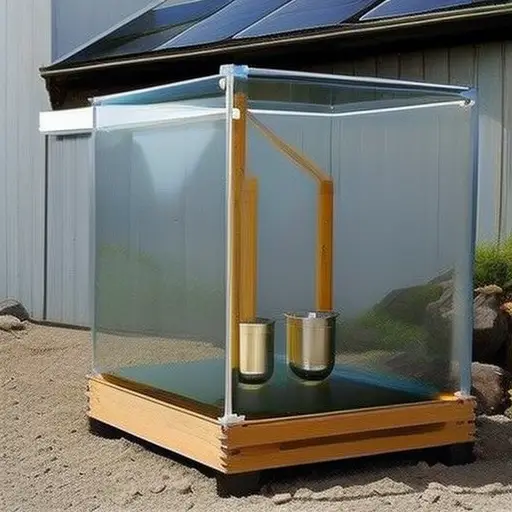Making Natural Medicines From Wild Plants

While modern medicine has made significant advancements, some individuals still question the effectiveness and safety of synthetic drugs. This concern has led to a growing interest in natural medicines derived from wild plants.
This article explores the process of making natural medicines from wild plants, addressing potential objections and providing a scientific perspective.
Discover the benefits of using wild plants for natural remedies, learn how to identify and harvest medicinal plants, and understand the essential steps for extracting healing properties.
Benefits of Using Wild Plants for Natural Medicines
What are the benefits of using wild plants for natural medicines?
Traditional uses of wild plants for medicinal purposes have been practiced by various cultures for centuries. In recent years, scientific research has provided evidence supporting the efficacy and safety of these natural medicines.
One of the key benefits of using wild plants is their accessibility. These plants can often be found in local ecosystems, making them readily available for use. Additionally, wild plants are often rich in bioactive compounds, such as alkaloids, flavonoids, and terpenoids, which have been shown to possess therapeutic properties. These compounds can help alleviate symptoms, treat diseases, and promote overall health and well-being.
Furthermore, wild plants offer a sustainable alternative to conventional medicine. The cultivation of medicinal plants often requires significant resources and can have negative environmental impacts. In contrast, wild plants can be harvested in a responsible and sustainable manner, minimizing the strain on ecosystems. This makes them an environmentally friendly option for natural medicines.
Identifying and Harvesting Wild Medicinal Plants
Identifying and harvesting wild medicinal plants requires a thorough understanding of their botanical characteristics and proper collection techniques. Wild plant identification is the first step in this process. It involves being able to recognize different plant species and understand their growth patterns, habitats, and unique features. This knowledge is crucial for distinguishing between medicinal plants and their non-medicinal counterparts.
Sustainable harvesting practices are essential to ensure the long-term availability of these valuable plant resources. It is important to only collect plants that are abundant in the wild and avoid overharvesting vulnerable or endangered species. Harvesting should also be done at the appropriate time, when the plants have reached their peak medicinal potency.
Careful collection techniques are necessary to preserve the integrity of the plants and their healing properties. This includes using sharp, clean tools to minimize damage to the plant and harvesting only the necessary parts, such as leaves, flowers, or roots, depending on the plant and its medicinal uses. It is also crucial to consider the overall health of the plant and its ecosystem, as well as any legal regulations or permits required for wild plant collection.
With a thorough understanding of wild plant identification and sustainable harvesting practices, we can now move on to the next step: extracting the healing properties from these valuable plants.
Extracting Healing Properties From Wild Plants
To extract the healing properties from wild plants, it is important to employ precise and professional techniques. The extraction process involves isolating the active compounds responsible for the medicinal effects of the plants. These compounds can vary greatly depending on the species and the specific health benefits they offer. Extracting the healing properties from wild plants is a crucial step in creating natural remedies from plants.
One commonly used method for extracting healing properties is through solvent extraction. This technique involves using a solvent, such as ethanol or water, to dissolve the active compounds from the plant material. The solvent is then evaporated, leaving behind a concentrated extract.
Another method is steam distillation, which is often used for extracting essential oils from aromatic plants. The plant material is subjected to steam, which helps release the volatile oils containing the medicinal properties. The steam is then condensed, and the essential oil is separated from the water.
Other techniques, such as maceration and infusion, are also employed depending on the desired extraction method and the specific properties of the plant.
Making Herbal Infusions and Decoctions
In the process of making natural medicines from wild plants, one important aspect is the extraction of medicinal properties through herbal infusions and decoctions. These methods involve using water or alcohol as solvents to extract the beneficial compounds from the plants.
Understanding the differences between water and alcohol extraction, as well as the specific medicinal properties of different plants, is crucial for producing effective herbal remedies.
Additionally, mastering the brewing techniques and tips can ensure optimal extraction and potency of the natural medicines.
Water Vs. Alcohol Extraction
The choice between water and alcohol extraction methods for making herbal infusions and decoctions is a crucial factor in producing natural medicines from wild plants. Each extraction method has its own advantages and effectiveness, depending on the desired outcome and the properties of the plant material being used.
-
Water Extraction:
-
Gentle and suitable for delicate plant parts
-
Ideal for extracting water-soluble compounds like vitamins and minerals
-
Provides a milder taste and aroma
-
Alcohol Extraction:
-
More effective in extracting plant constituents like essential oils and resins
-
Helps to preserve the medicinal properties of the plant
-
Offers a longer shelf life for the herbal preparation
Understanding the comparison and effectiveness of these extraction methods is essential for herbalists and natural medicine practitioners to ensure the desired therapeutic effects are achieved. Whether one chooses water or alcohol extraction, it is important to consider the specific properties of the plant and the intended use of the natural medicine.
Medicinal Properties of Plants
One key aspect to consider when making herbal infusions and decoctions is understanding the diverse medicinal properties of plants. Different plants contain various compounds that can have specific effects on the human body. Herbal infusions and decoctions are traditional remedies that have been used for centuries to harness the healing powers of plants. These natural remedies can provide relief for a wide range of ailments, from digestive issues to respiratory problems.
To give you a better understanding of the medicinal properties of plants, here is a table highlighting some common plants and their respective health benefits:
| Plant Name | Medicinal Property | Traditional Remedy |
|---|---|---|
| Chamomile | Calming and anti-inflammatory properties | Insomnia and anxiety |
| Peppermint | Digestive aid and pain reliever | Upset stomach |
| Echinacea | Immune-boosting and anti-viral effects | Cold and flu |
| Ginger | Anti-inflammatory and anti-nausea properties | Nausea and inflammation |
| Lavender | Relaxing and sleep-inducing properties | Anxiety and insomnia |
Understanding the medicinal properties of plants is crucial for creating effective herbal infusions and decoctions. These natural remedies not only provide relief but also have antioxidant effects, helping to promote overall health and well-being.
Brewing Techniques and Tips
Continuing the exploration of brewing techniques and tips for making herbal infusions and decoctions, it is important to understand the specific methods and processes involved in extracting the medicinal properties of wild plants. Brewing methods play a crucial role in maximizing the potency and effectiveness of the final product.
Here are some key tips to consider:
-
Choose the right brewing method: Depending on the plant material and desired outcome, you can opt for either an infusion or a decoction.
-
Infusion: This method involves steeping the plant material in hot water to extract the medicinal compounds. It is best suited for delicate plant parts like leaves, flowers, and aerial parts.
-
Decoction: This technique involves simmering the plant material in water to extract the medicinal properties of tougher plant parts like roots, bark, and seeds.
By understanding and employing these brewing methods, you can harness the full potential of wild plants. Additionally, experimenting with alternative ingredients can yield unique flavors and enhance the therapeutic benefits of your herbal brews.
Now, let’s delve into the next section, which focuses on creating herbal tinctures and salves.
Creating Herbal Tinctures and Salves
To begin the discussion on creating herbal tinctures and salves, let us explore the process of formulating these natural remedies using wild plants. Creating natural remedies involves harnessing the healing properties of various plant species and preserving their potency.
Herbal tinctures are concentrated extracts made by steeping plant material in alcohol or a mixture of alcohol and water. This process allows the active constituents of the plants to be extracted, resulting in a highly concentrated liquid remedy. To create a tincture, the plant material is typically chopped or ground and placed in a jar. Alcohol is then added to cover the plant material completely. The mixture is left to steep for several weeks, allowing the alcohol to extract the beneficial compounds from the plants. Finally, the liquid is strained and stored in a dark glass bottle to maintain its potency.
Salves, on the other hand, are semi-solid herbal preparations that are typically used topically. They are made by infusing plant material in a carrier oil and combining it with beeswax to create a balm-like consistency. The plant material is gently heated in the oil to extract its properties, and then the mixture is strained and combined with melted beeswax. The salve is poured into containers and left to cool and solidify.
Ensuring Safety and Effectiveness of Natural Medicines
Ensuring the safety and effectiveness of natural medicines requires thorough testing and quality control measures. When it comes to natural medicines, it is crucial to establish proper quality control procedures and regulatory compliance to guarantee the safety and efficacy of these products. Here are three key factors to consider:
-
Standardization: Ensuring quality control in natural medicines involves standardizing the production process. This includes using consistent methods for harvesting, processing, and extracting the active ingredients from the plants. Standardization helps maintain the potency and consistency of the final product.
-
Testing: Rigorous testing is essential to assess the safety and efficacy of natural medicines. This includes conducting laboratory tests to identify and quantify active compounds, as well as testing for potential contaminants such as heavy metals, pesticides, and microbial contaminants. Additionally, clinical trials are conducted to evaluate the effectiveness and safety of the natural medicine in humans.
-
Regulatory Compliance: Adhering to regulatory guidelines is crucial to ensure the safety and effectiveness of natural medicines. Regulatory bodies establish guidelines and standards that manufacturers must follow to ensure product quality and safety. Compliance with these regulations helps protect consumers and ensures that natural medicines are produced in a controlled and consistent manner.
Frequently Asked Questions
Are There Any Specific Wild Plants That Should Be Avoided for Making Natural Medicines Due to Safety Concerns?
There are specific wild plants that should be avoided for making natural medicines due to safety concerns. These plants may have toxic compounds or adverse effects on human health, highlighting the importance of proper knowledge and research before using them in medicinal preparations.
Can the Same Wild Plant Be Used for Different Types of Natural Medicines, Such as Infusions, Tinctures, and Salves?
Different uses for the same wild plant in natural medicine include infusions, tinctures, and salves. Utilizing wild plants for natural medicine offers numerous benefits, such as their abundance, potential therapeutic properties, and the ability to source sustainable and locally available remedies.
What Are Some Common Mistakes to Avoid When Identifying and Harvesting Wild Medicinal Plants?
When it comes to identifying and harvesting wild medicinal plants, it’s crucial to avoid common mistakes. By following proper techniques and guidelines, one can maximize the effectiveness of natural medicines made from these plants.
Are There Any Specific Tools or Techniques That Are Recommended for Extracting Healing Properties From Wild Plants?
Recommended tools and techniques for extracting healing properties from wild plants include maceration, infusion, and distillation. These methods allow for the extraction of beneficial compounds, such as essential oils and active constituents, which can then be used in natural medicine formulations.
How Can One Ensure the Effectiveness and Potency of Natural Medicines Made From Wild Plants?
Ensuring the effectiveness and potency of natural medicines made from wild plants requires rigorous quality control measures. This involves testing for active compounds, standardizing extraction techniques, and ensuring sustainable harvesting practices to maintain plant populations for future use.
Conclusion
In the realm of natural medicine, wild plants hold immense potential. Their healing properties can be harnessed through careful identification, harvesting, and extraction techniques.
From herbal infusions to tinctures and salves, a myriad of remedies can be created. However, it is crucial to prioritize safety and effectiveness when utilizing these natural medicines.
By delving into the vast world of wild plants, we unlock a harmonious symphony of healing, where nature’s whispers guide us towards holistic wellness.





